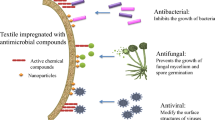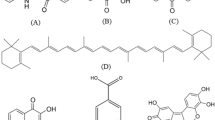Abstract
With the growing concern for health and wellness, many textile mills are witnessing a surge in demand for antimicrobial and anti-viral treatments on fabric. The black cumin seed (BCS) is blessed with various antioxidants and antimicrobial active agents, and can be used to develop antimicrobial fabric. The current study aims to prepare a stable emulsion with BCS oil to apply on casual knitted fabric to investigate its anti-bacterial properties. The homogenous emulsions were prepared with Tween-80 surfactant and applied to the fabric by exhaust method. Thus, the emulsions were stable at various temperatures. The surface functional groups of treated fabric were characterized with FT-IR spectroscopy and the surface morphology was visualized with SEM images to confirm the modification. The FT-IR spectrum of treated fabric guaranteed successful modification, presenting the major surface functional groups in the treated fabric. The SEM images further confirmed this phenomenon as the treated fabric exhibited cemented layer deposition of BCS emulsions. The anti-bacterial activity of treated fabric against Bacillus subtilis microbes was measured using the Kirbey–Bauer method. The result showed that the treated fabric demonstrated anti-bacterial activity against B. subtilis with an inhibition zone of 8 mm. The resistive activity against the target bacteria was found active even after a single wash. This was proven through the optical density test which indicated that the fabric can be used for healthcare PPF securing their antimicrobial and anti-viral properties.
Graphical Abstract











Similar content being viewed by others
Data Availability
Data will be provided upon request.
Abbreviations
- BCS:
-
Black cumin seed
- SEM:
-
Scanning electronic microscopy
- O/W:
-
Oil-in-water
- UCC:
-
Ultrasonic cell crusher
- FT-IR:
-
Fourier transform infrared radiation
- OD:
-
Optical density
- PPF:
-
Personal protective fabric
References
S. Mollick, T. Islam, M.R. Miah, M. Mehedi, H. Riad, T. Chakrabarty, M.T. Hossen, M.T. Islam, Development of antibacterial cotton fabric utilizing microencapsulation technique from dragon fruit peel extract. Fibers Polym. 1, 3 (2023). https://doi.org/10.1007/s12221-023-00353-y
R.M. Cloud, W. Cao, G. Song, Functional finishes to improve the comfort and protection of apparel, in In Advances in the Dyeing and Finishing of Technical Textiles. (Elsevier, Amsterdam, Netherlands, 2013), pp. 258–279
A. Ahmad, A. Husain, M. Mujeeb, S.A. Khan, A.K. Najmi, N.A. Siddique, Z.A. Damanhouri, F. Anwar, A review on therapeutic potential of Nigella Sativa: a miracle herb. Asian Pac. J. Trop. Biomed. 3, 337–352 (2013). https://doi.org/10.1016/S2221-1691(13)60075-1
M.A. Khan, Thymoquinone, a constituent of prophetic medicine-black seed, is a miracle therapeutic molecule against multiple diseases. Int. J. Health Sci. (Qassim) 13, 1–2 (2019)
S.J. Mohammed, H.H.H. Amin, S.B. Aziz, A.M. Sha, S. Hassan, J.M. Abdul Aziz, H.S. Rahman, Structural characterization, antimicrobial activity, and in vitro cytotoxicity effect of black seed oil. Evid. based Complement. Altern. Med. (2019). https://doi.org/10.1155/2019/6515671
L. Urbánková, V. Kašpárková, P. Egner, O. Rudolf, E. Korábková, Caseinate-stabilized emulsions of black cumin and tamanu oils: preparation characterization and antibacterial activity. Polym. (Basel) (2019). https://doi.org/10.3390/polym11121951
S. Kentish, T.J. Wooster, M. Ashokkumar, S. Balachandran, R. Mawson, L. Simons, The use of ultrasonics for nanoemulsion preparation. Innov. Food Sci. Emerg. Technol. 9, 170–175 (2008). https://doi.org/10.1016/J.IFSET.2007.07.005
A. Chevallier, Encyclopedia of Medicinal Plants (Dorling Kindersley, New York, 1996)
S.A. Ghazanfar, Handbook of Arabian Medicinal Plants (CRC Press, Boca Raton, 1994)
N.K. Sharma, D. Ahirwar, D. Jhade, S. Gupta, Medicinal and phamacological potential of Nigella Sativa: a review. Ethnobot. Leafl. 7, 11 (2009)
H.R. Sharif, S. Abbas, H. Majeed, W. Safdar, M. Shamoon, M.A. Khan, M. Shoaib, H. Raza, J. Haider, Formulation, characterization and antimicrobial properties of black cumin essential oil nanoemulsions stabilized by OSA starch. J. Food Sci. Technol. 54, 3358–3365 (2017). https://doi.org/10.1007/s13197-017-2800-8
S.J. Carter, Gunn’s Dispensing for Pharmaceutical Students, 12th edn. (CBS publisher and Distributors, New Delhi, 1987). p. 250
M.G. Song, S.H. Jho, J.Y. Kim, J.D. Kim, Rapid evaluation of water-in-oil (w/o) emulsion stability by turbidity ratio measurements. J. Colloid Interface Sci. 230, 213–215 (2000). https://doi.org/10.1006/jcis.2000.7090
F. Goodarzi, S. Zendehboudi, A comprehensive review on emulsions and emulsion stability in chemical and energy industries. Can. J. Chem. Eng. 97, 281–309 (2019). https://doi.org/10.1002/cjce.23336
G. Chen, D. Tao, An experimental study of stability of oil-water emulsion. Fuel Process. Technol. 86, 499–508 (2005). https://doi.org/10.1016/j.fuproc.2004.03.010
M. Jaiswal, R. Dudhe, P.K. Sharma, Nanoemulsion: an advanced mode of drug delivery system. 3 Biotech 5, 123–127 (2015). https://doi.org/10.1007/s13205-014-0214-0
B.G. Pollet, J.T.E. Goh, The importance of ultrasonic parameters in the preparation of fuel cell catalyst inks. Electrochim. Acta 128, 292–303 (2014). https://doi.org/10.1016/j.electacta.2013.09.160
A.A. Ochoa, J.A. Hernández-Becerra, A. Cavazos-Garduño, E.J. Vernon-Carter, H.S. García, Preparation and characterization of curcumin nanoemulsions obtained by thin-film hydration emulsification and ultrasonication methods. Rev. Mex. Ing. Quim. 15, 79–90 (2016)
C. Prieto, L. Calvo, Performance of the biocompatible surfactant tween 80, for the formation of microemulsions suitable for new pharmaceutical processing. J. Appl. Chem. 2013, 1–10 (2013). https://doi.org/10.1155/2013/930356
E. Dickinson, C.M. Woskett, Effect of alcohol on adsorption of casein at the oil—water interface. Food Hydrocoll. 2, 187–194 (1988). https://doi.org/10.1016/S0268-005X(88)80017-1
M.F. Ramadan, K.M.M. Wahdan, Blending of corn oil with black cumin (Nigella Sativa) and coriander (Coriandrum Sativum) seed oils: impact on functionality, stability and radical scavenging activity. Food Chem. 132, 873–879 (2012). https://doi.org/10.1016/j.foodchem.2011.11.054
M. Kiralan, G. Özkan, A. Bayrak, M.F. Ramadan, Physicochemical properties and stability of black cumin (Nigella Sativa) seed oil as affected by different extraction methods. Ind. Crops Prod. 57, 52–58 (2014). https://doi.org/10.1016/j.indcrop.2014.03.026
M.F.R. Hassanien, A.M.A. Assiri, A.M. Alzohairy, H.F. Oraby, Health-promoting value and food applications of black cumin essential oil: an overview. J. Food Sci. Technol. 52, 6136–6142 (2015). https://doi.org/10.1007/s13197-015-1785-4
M.L. Foo, C.W. Ooi, K.W. Tan, I.M.L. Chew, Preparation of black cumin seed oil pickering nanoemulsion with enhanced stability and antioxidant potential using nanocrystalline cellulose from oil palm empty fruit bunch. Chemosphere 287, 132108 (2022). https://doi.org/10.1016/j.chemosphere.2021.132108
A.C. Ferreira, A. Sullo, S. Winston, I.T. Norton, A.B. Norton-Welch, Influence of ethanol on emulsions stabilized by low molecular weight surfactants. J. Food Sci. 85, 28–35 (2020). https://doi.org/10.1111/1750-3841.14947
E. Dickinson, C.M. Woskett, Effect of alcohol on adsorption of casein at the oil—water interface. Top. Catal. 2, 187–194 (1988). https://doi.org/10.1016/S0268-005X(88)80017-1
G.P. Espinosa, M.G. Scanlon, Characterization of alcohol-containing dairy emulsions: pseudo-ternary phase diagrams of sodium caseinate solution-oil-ethanol systems. Food Res. Int. 53, 49–55 (2013). https://doi.org/10.1016/j.foodres.2013.03.006
A.R. Zakinyan, L.M. Kulgina, A.A. Zakinyan, S.D. Turkin, Electrical conductivity of field-structured emulsions. Fluids (2020). https://doi.org/10.3390/fluids5020074
A.S. Peshkovsky, S.L. Peshkovsky, S. Bystryak, Scalable high-power ultrasonic technology for the production of translucent nanoemulsions. Chem. Eng. Process. 69, 77–82 (2013). https://doi.org/10.1016/j.cep.2013.02.010
S. Mahdi Jafari, Y. He, B. Bhandari, Nano-emulsion production by sonication and microfluidization-a comparison. Int. J. Food Prop. 9, 475–485 (2006). https://doi.org/10.1080/10942910600596464
M.K. Poindexter, S. Chuai, R.A. Marble, S.C. Marsh, Solid content dominates emulsion stability predictions. Energy Fuels 19, 1346–1352 (2005). https://doi.org/10.1021/ef049797w
Y.T. Koh, S.A. Higgins, J.S. Weber, W.M. Kast, Immunological consequences of using three different clinical/laboratory techniques of emulsifying peptide-based vaccines in incomplete freund’s adjuvant. J. Transl. Med. 4, 42 (2006). https://doi.org/10.1186/1479-5876-4-42
S. Zaman Smrity, Stability analysis of formulated emulsion containing black cumin (Nigella Sativa) oil. Am. J. Biomed. Life Sci. 4, 49 (2016). https://doi.org/10.11648/j.ajbls.20160403.15
T. Islam, A.M. Khan, Md.R. Karim, S. Hossain, M.A. Jalil, Assessing the dyeing efficacy and environmental impact of cotton fabric dyed with sawmill bio-waste extracts and metal salts. SPE Polym. (2024). https://doi.org/10.1002/pls2.10136
A.B. pathol, A.J. clin, Undefined antibiotic susceptibility testing by a standardized single disc method. (1966), ci.nii.ac.jp
M. Kiralan, Changes in volatile compounds of black cumin (Nigella Sativa L) seed oil during thermal oxidation. Int. J. Food Prop. 17, 1482–1489 (2014). https://doi.org/10.1080/10942912.2012.723231
B. Latreille, P. Paquin, Evaluation of emulsion stability by centrifugation with conductivity measurements. J. Food Sci. 55, 1666–1668 (1990). https://doi.org/10.1111/j.1365-2621.1990.tb03595.x
M.K. Poindexter, R.A. Marble, S.C. Marsh, The key to predicting emulsion stability: solid content, 2006
Q. Xu, M. Nakajima, H. Nabetani, S. Iwamoto, X. Liu, The effects of ethanol content and emulsifying agent concentration on the stability of vegetable oil-ethanol emulsions. J.Am. Oil Chem. Soc. 78, 12 (2001)
S.J. Mohammed, H.H.H. Amin, S.B. Aziz, A.M. Sha, S. Hassan, J.M. Abdul Aziz, H.S. Rahman, Structural characterization, antimicrobial activity, and in vitro cytotoxicity effect of black seed oil. Evid. Based Complement. Altern. Med. 2019, 1–9 (2019). https://doi.org/10.1155/2019/6515671
B. Alizadeh Behbahani, M. Noshad, F. Falah, Cumin essential oil: phytochemical analysis, antimicrobial activity and investigation of its mechanism of action through scanning electron microscopy. Microb. Pathog. 136, 103716 (2019). https://doi.org/10.1016/J.MICPATH.2019.103716
H. Al-Karagoly, A. Rhyaf, H. Naji, S. Albukhaty, F.A. AlMalki, A.A. Alyamani, J. Albaqami, S. Aloufi, Green synthesis, characterization, cytotoxicity, and antimicrobial activity of iron oxide nanoparticles using Nigella Sativa seed extract. Green Process. Synth. 11, 254–265 (2022). https://doi.org/10.1515/gps-2022-0026
M. Makarem, C.M. Lee, K. Kafle, S. Huang, I. Chae, H. Yang, J.D. Kubicki, S.H. Kim, Probing cellulose structures with vibrational spectroscopy. Cellulose 26, 35–79 (2019). https://doi.org/10.1007/s10570-018-2199-z
M.M. Bashar, H. Zhu, S. Yamamoto, M. Mitsuishi, Highly carboxylated and crystalline cellulose nanocrystals from jute fiber by facile ammonium persulfate oxidation. Cellulose 26, 3671–3684 (2019). https://doi.org/10.1007/s10570-019-02363-7
M.M. Bashar, H. Zhu, S. Yamamoto, M. Mitsuishi, Superhydrophobic surfaces with fluorinated cellulose nanofiber assemblies for oil-water separation. RSC Adv. 7, 37168–37174 (2017). https://doi.org/10.1039/C7RA06316D
G. Akhlamadi, E.K. Goharshadi, Sustainable and superhydrophobic cellulose nanocrystal-based aerogel derived from waste tissue paper as a sorbent for efficient oil/water separation. Process. Saf. Environ. Prot. 154, 155–167 (2021). https://doi.org/10.1016/J.PSEP.2021.08.009
M. Akram Khan, M. Afzal, Chemical composition of Nigella Sativa Linn: part 2 recent advances. Inflammopharmacology 24, 67–79 (2016). https://doi.org/10.1007/s10787-016-0262-7
D.J. McClements, Critical review of techniques and methodologies for characterization of emulsion stability. Crit. Rev. Food Sci. Nutr. 47, 611–649 (2007)
S. Galié, C. García-Gutiérrez, E.M. Miguélez, C.J. Villar, F. Lombó, Biofilms in the food industry: health aspects and control methods. Front. Microbiol. 9, 1–18 (2018). https://doi.org/10.3389/fmicb.2018.00898
H.C. Flemming, J. Wingender, U. Szewzyk, P. Steinberg, S.A. Rice, S. Kjelleberg, Biofilms: an emergent form of bacterial life. Nat. Rev. Microbiol. 14, 563–575 (2016). https://doi.org/10.1038/nrmicro.2016.94
Acknowledgements
The authors greatly appreciate the financial support from the University Grants Commission of Bangladesh (UGC) through the Research Cell of Mawlana Bhashani Science and Technology University, Santosh, Tangail, 1902, Bangladesh. They also thank Professor Dr. Joykrisna Saha, from the Department of Textile Engineering at Mawlana Bhashani Science and Technology University, Tangail, 1902, Bangladesh, for his kind support in investigating the antimicrobial activity of the treated fabric. Additionally, the authors acknowledge the Nonwoven Material Research Lab in the Department of Textiles, Merchandising, and Interiors at the University of Georgia, Athens, Georgia 30602, United States, for providing technical support.
Funding
This research was funded by the University Grants Commission, Bangladesh, through the Research Cell of Mawlana Bhashani Science and Technology University for the fiscal year 2023–2024. The specific research grant number is 20232024/30.
Author information
Authors and Affiliations
Contributions
M.I.M.: Resources, Methodology, Validation, Investigation, Writing—original draft, Writing—review and editing; A.D.P, MMH, MSI: Resources, Investigation, Methodology, Writing—original draft; T.I.: Resources, Investigation, Methodology, Validation, Writing—review and editing; F.T.Z.: Resources, Supervision, Investigation, Methodology, Writing—review and editing; M.I.H., G.B.: Formal analysis, Visualization, Writing—review and editing; M.M.B.: Conceptualization, Supervision, Investigation, Formal analysis, Visualization, Writing—review and editing.
Corresponding authors
Ethics declarations
Conflict of Interest
The authors declare no conflict of interest.
Ethical Approval
Not applicable.
Rights and permissions
Springer Nature or its licensor (e.g. a society or other partner) holds exclusive rights to this article under a publishing agreement with the author(s) or other rightsholder(s); author self-archiving of the accepted manuscript version of this article is solely governed by the terms of such publishing agreement and applicable law.
About this article
Cite this article
Hosen, M.I., Pranta, A.D., Hasan, M.M. et al. Preparation and Application of Black Cumin Seed Oil Emulsion with Enhanced Stability for Antimicrobial Treatment of Cellulosic Fabric. Fibers Polym (2024). https://doi.org/10.1007/s12221-024-00601-9
Received:
Revised:
Accepted:
Published:
DOI: https://doi.org/10.1007/s12221-024-00601-9




